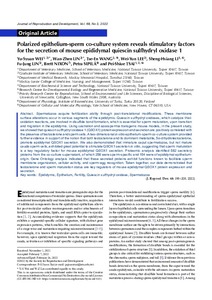Polarized epithelium-sperm co-culture system reveals stimulatory factors for the secretion of mouse epididymal quiescin sulfhydryl oxidase 1
Lin Wan-Zhen; Nixon B; Sipila P; Wei Yu-Syuan; Wang Tse-En; Tsai PS; Li Sheng-Hsiang; Lin Fu-Jung; Lee Wei-Yun
https://urn.fi/URN:NBN:fi-fe2022091258715
Tiivistelmä
Spermatozoa acquire fertilization ability through post-translational modifications. These membrane surface alterations occur in various segments of the epididymis. Quiescin sulfhydryl oxidases, which catalyze thioloxidation reactions, are involved in disulfide bond formation, which is essential for sperm maturation, upon transition and migration in the epididymis. Using castration and azoospermia transgenic mouse models, in the present study, we showed that quiescin sulfhydryl oxidase 1 (QSOX1) protein expression and secretion are positively correlated with the presence of testosterone and sperm cells. A two-dimensional in vitro epithelium-sperm co-culture system provided further evidence in support of the notion that both testosterone and its dominant metabolite, 5 alpha-dihydrotestosterone, promote epididymal QSOX1 secretion. We also demonstrated that immature caput spermatozoa, but not mature cauda sperm cells, exhibited great potential to stimulate QSOX1 secretion in vitro, suggesting that sperm maturation is a key regulatory factor for mouse epididymal QSOX1 secretion. Proteomic analysis identified 582 secretory proteins from the co-culture supernatant, of which 258 were sperm-specific and 154 were of epididymal epitheliumorigin. Gene Ontology analysis indicated that these secreted proteins exhibit functions known to facilitate sperm membrane organization, cellular activity, and sperm-egg recognition. Taken together, our data demonstrated that testosterone and sperm maturation status are key regulators of mouse epididymal QSOX1 protein expression and secretion.
Kokoelmat
- Rinnakkaistallenteet [19207]
